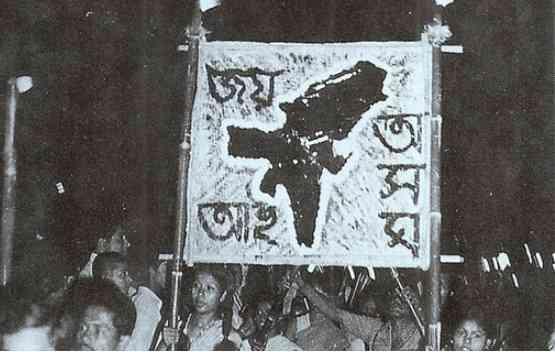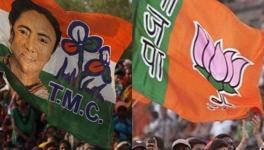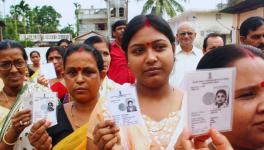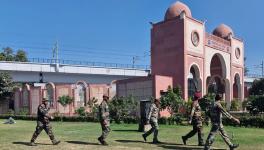Assam and the CAA: A Pre-Independence Timeline
This is the first of a three-part series tracing the leading events in Assam’s politics of language, religion, ethno-nationalism and citizenship from the nineteenth century to the present day.

A poster saying 'Joi Aai Axom' which had gained popularity during the Assam movement.
This is the first of a three-part series tracing the leading events in Assam’s politics of language, religion, ethno-nationalism and citizenship from the nineteenth century to the present day.
- 1826: Treaty of Yandabo transfers control of Assam (along with Manipur, Rakhine and the Taninthayi coast south of the Salween river) from the King of Burma to the English East India Company. Initially kept as a “protectorate” with an Ahom ruler, Assam is formally annexed to the Company’s territories in 1838.
Assam’s Goalpara district has been under Company rule since the transfer of Bengal’s diwani (tax collection) rights under the Treaty of Allahabad, 1765, between Robert Clive and Shah Alam II. - 1836: Bengali is declared the language of the law courts, replacing Persian. Bengali also becomes the medium of instruction in educational institutions.
- 1837: The first English tea garden is established at Chabua in Upper Assam. In 1840, the Assam Tea Company launches commercial production – initially using Chinese workers, who leave during the 1840s. From the 1850s onwards, workers are brought in from the regions that later make up Bihar, Jharkhand, Chhattisgarh, West Bengal, Odisha and Andhra Pradesh. (A large part of the workforce is adivasi. Also termed the tea tribes, these workers are today spread over some 800 tea estates.) Later in the nineteenth century, workers from outside the region are engaged as unskilled labour in the coal, railway and petroleum sectors. (The first rail line is laid in 1882; oil is discovered at Digboi in 1889.) Another workforce, this one administrative – consisting of clerks, judges, revenue collectors and plantation overseers – is recruited largely from Bengal. At the start of the twentieth century, nearly all of Assam’s trained and educated workforce – doctors, lawyers, teachers, journalists, etc. – are Bengali speakers.
- 1871: The first census of India reveals an altering demography in Assam, with settlers from densely populated Bengal moving in, a consequence of the colonial government’s policy of importing labour and encouraging settlers.
- 1872: Assamese is declared the language of education and administration for native speakers.
- 1873: The Bengal Eastern Frontier Regulation Act is promulgated, establishing a system of “Inner Line” passes to keep “non-tribal” plains people out of the hill areas. But the new system also serves to lock the hill people out of profitable new enterprises on the plains – i.e., from economic opportunity and participation – while minimising the government’s responsibilities and expenditure in the Inner Line areas. The “surplus producing” plains communities gain cultural and economic predominance in the region. The permit system’s mechanism of internal locks affects movement and socialisation in the decades ahead, leading to charges of aggression between hill tribes and plains people, ethnic clashes, secessionist demands, the fragmentation of administrative units, and tense borders between states to this day. The “protection” of hill tribes remains the official rationale of the inner-line permit system. As identities and rivalries harden, the incentive to break away is reinforced.
- 1874: Assam becomes a Chief Commissioner’s Province, with Assamese as the sole medium of instruction in primary schools. Bengali is retained at the secondary and high school level till the end of the century. Sylhet from the Bengal province is made part of Assam. The Assam province also includes Bengali-majority areas in what are today the Cachar, Hailakandi and Karimganj districts of the Barak Valley region.
- 1905: The Partition of Bengal places Assam in East Bengal. When the partition is annulled in 1912, Assam (with Sylhet) reverts to being a Chief Commissioner’s Province.
- 1914 onwards begins the large-scale arrival of Bengali immigrants of the poorer communities – peasants, fishing folk, mostly Muslim, but also dalit (most notably of the namashudra community). Their rates of arrival fluctuate, quickening and ebbing from one decade to the next. They work as labourers and go on to establish themselves in the Brahmaputra floodplains (chaporis), practising a new kind of agriculture: on the principle of land ownership or permanent tenure, where shifting and temporary ownership had been customary; by multi-cropping (whereas slash and burn had been the norm till then); and by cultivating the chars (sandbanks) in the dry season. The question of borders does not arise as both Bengal and Assam are part of British India. However, in 1916, the government introduces the “line system” meant to keep the incomers separate from the local population by restricting the former group to the chars.
- 1917: The Assam Sahitya Sabha is founded. In the decades ahead, it will play an active role in language politics, especially during the Assam Agitation of 1979–85 (see Part II: 1947 to the Assam Accord).
- 1932: C.S. Mullan, a British census superintendent, writes in his report of the census: “Probably the most important event in the province during the last 25 years, likely to alter permanently the whole structure of the Assamese culture and civilisation, has been the invasion of a vast horde of land-hungry Bengali immigrants, mostly Muslims from the districts of eastern Bengal.” Those figures of speech – “vast horde” and “invasion” – will haunt Assam’s politics in the decades ahead.
The 1931 census reveals that Assamese speakers constitute 31.42 per cent of the population. Their proportion jumps up to 56.69 per cent in 1951. (The sharp fluctuations arise from the formation and disintegration of political alliances between communities, with ethnic and linguistic minorities sometimes declaring Assamese as their “mother tongue” and sometimes a different language. Bengali speakers are divided by region of origin, religion, caste and dialect.) - 1937: A Muslim League government comes to power in Assam, under Mohammad Saadullah. The government enjoys three stints in power: April 1937–September 1938, November 1939–December 1941, and August 1942–February 1946. The government launches a “Grow More Food” programme, and opens up the grazing reserves to encourage settlers from East Bengal to move into Assam. The immediate backdrop of the policy is one of wartime shortages and the Bengal Famine. However, Viceroy Lord Wavell describes the programme as “grow more Muslims”, viewing it as an insidious project of demographic re-engineering. In 1946, Assam produces a surplus of rice.
- 1939: The Registration of Foreigners Act is promulgated. A wartime law, it requires foreigners travelling in India to report themselves “to a prescribed authority” on arrival at every new place, declaring the details of their present location and the intended duration of their stay. In the event of authorities checking on an individual, the onus of proving s/he is not a foreigner rests with the individual.
- 1946: The Foreigners Act is passed by the Imperial Legislative Assembly in Delhi. It defines as a foreigner “a person who is not a citizen of India”, places the onus of proving citizenship on the person accused of being a foreigner, and empowers the government to hold such a person in custody until his/her deportation to the country of origin.
- 1946, October: Three pracharaks (disseminators or missionaries) of the RSS, Dadarao Parmarth, Vasantrao Oak and Krishna Paranjpe, arrive in Assam and set up the first RSS shakhas (branches) in Guwahati, Dibrugarh and Shillong. From here begins an enterprise that will culminate in the BJP’s dominance across the North-East seventy years later.
Read part 2 here.
Courtesy:
Indian Cultural Forum,
Original published date:
Get the latest reports & analysis with people's perspective on Protests, movements & deep analytical videos, discussions of the current affairs in your Telegram app. Subscribe to NewsClick's Telegram channel & get Real-Time updates on stories, as they get published on our website.
























